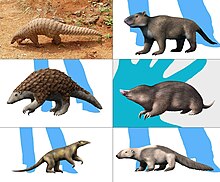Pholidotamorpha
| Pholidotamorphs Temporal range:
| |
|---|---|

| |
| Various Pholidotamorph genera; clockwise from top left: Manis, Ernanodon, Xenocranium, Metacheiromys, Eurotamandua, Eomanis. | |
| Scientific classification | |
| Domain: | Eukaryota |
| Kingdom: | Animalia |
| Phylum: | Chordata |
| Class: | Mammalia |
| Mirorder: | Ferae |
| Clade: | Pholidotamorpha Gaudin et al., 2009[1] |
| Orders | |
Pholidotamorpha ("pangolin-like forms") is a clade of placental mammals from mirorder Ferae that includes the order Pholidota (the pangolins) and extinct order Palaeanodonta.[1]
Classification and phylogeny
[edit]History of taxonomy
[edit]Both the Pholidota and Palaeanodonta orders were formerly classified with various other orders of ant-eating mammals, most notably Xenarthra (armadillos, sloths and true anteaters) which they superficially resemble. Some past palaeontologists placed pangolins and palaeanodonts as a suborder "Pholidota" in order Cimolesta, alongside the extinct family Ernanodontidae as a separate suborder Ernanodonta near it, but this idea fell out of favor when it was determined that cimolestids were not placental mammals.[2]
Newer genetic evidence indicates instead that the closest living relatives to order Pholidota are the members of order Carnivora, and together they form the mirorder Ferae.[3][4][5] In 2009, pangolins and palaeanodonts were together placed within clade Pholidotamorpha.[1] A 2012 study from new remains found in Late Paleocene Mongolian strata have led to the assessment that extinct genus Ernanodon is closely related to extinct genus Metacheiromys and being a member of the extinct order Palaeanodonta.[6]
Classification
[edit]- Clade: Pholidotamorpha (Gaudin, 2009)
- Order: Pholidota (Weber, 1904) (pangolins)
- Suborder: Eupholidota (Gaudin, 2009) (true pangolins)
- Family: †Eurotamanduidae (Szalay & Schrenk, 1994)
- Genus: †Euromanis (Gaudin, 2009)
- Incertae sedis
- †Pholidota sp. [BC 16’08] (Pickford, 2008)
- Order: †Palaeanodonta (Matthew, 1918) (stem-pangolins)
- Family: †Epoicotheriidae (paraphyletic family) (Simpson, 1927)
- Family: †Ernanodontidae (Ding, 1979)
- Family: †Escavadodontidae (Rose & Lucas, 2000)
- Family: †Metacheiromyidae (paraphyletic family) (Wortman, 1903)
- Incertae sedis:
- Genus: †Arcticanodon (Rose, 2004)
- Genus: †Melaniella (Fox, 1984)
- Order: Pholidota (Weber, 1904) (pangolins)
Phylogeny
[edit]The phylogenetic relationships of clade Pholidotamorpha are shown in the following cladogram:[7][8][1][6][9][10][11]
| Ferae |
|
†Epoicotherium/Xenocranium clade | |||||||||||||||||||||
See also
[edit]References
[edit]- ^ a b c d Gaudin, Timothy (2009). "The Phylogeny of Living and Extinct Pangolins (Mammalia, Pholidota) and Associated Taxa: A Morphology Based Analysis" (PDF). Journal of Mammalian Evolution. 16 (4). Heidelberg, Germany: Springer Science+Business Media: 235–305. doi:10.1007/s10914-009-9119-9. S2CID 1773698. Archived from the original (PDF) on 2015-09-25. Retrieved 2020-08-05.
- ^ Rook, D. L.; Hunter, J. P. (2013). "Rooting Around the Eutherian Family Tree: the Origin and Relations of the Taeniodonta". Journal of Mammalian Evolution. 21: 1–17. doi:10.1007/s10914-013-9230-9. S2CID 17074668.
- ^ Murphy, Willian J., et al. (2001-12-14). "Resolution of the Early Placental Mammal Radiation Using Bayesian Phylogenetics". Science. 294 (5550): 2348–2351. Bibcode:2001Sci...294.2348M. doi:10.1126/science.1067179. PMID 11743200. S2CID 34367609.
- ^ Beck, Robin MD; Bininda-Emonds, Olaf RP; Cardillo, Marcel; Liu, Fu-Guo; Purvis, Andy (2006). "A higher-level MRP supertree of placental mammals". BMC Evolutionary Biology. 6 (1): 93. doi:10.1186/1471-2148-6-93. PMC 1654192. PMID 17101039.
- ^ Mark S Springer, Christopher A Emerling, John Gatesy, Jason Randall, Matthew A. Collin, Nikolai Hecker, Michael Hiller, Frédéric Delsuc (2019) Odontogenic ameloblast-associated (ODAM) is inactivated in toothless/enamelless placental mammals and toothed whales
- ^ a b Kondrashov, Peter; Agadjanian, Alexandre K. (2012). "A nearly complete skeleton of Ernanodon (Mammalia, Palaeanodonta) from Mongolia: morphofunctional analysis". Journal of Vertebrate Paleontology. 32 (5): 983–1001. doi:10.1080/02724634.2012.694319. ISSN 0272-4634. S2CID 86059673.
- ^ Amrine-madsen, H.; Koepfli, K.P.; Wayne, R.K.; Springer, M.S. (2003). "A new phylogenetic marker, apolipoprotein B, provides compelling evidence for eutherian relationships". Molecular Phylogenetics and Evolution. 28 (2): 225–240. doi:10.1016/S1055-7903(03)00118-0. PMID 12878460.
- ^ Kenneth D. Rose (2008). "Palaeanodonta and Pholidota". 9 - Palaeanodonta and Pholidota. pp. 135–146. doi:10.1017/CBO9780511541438.010. ISBN 9780521781176.
- ^ Halliday, Thomas J. D.; Upchurch, Paul; Goswami, Anjali (2015). "Resolving the relationships of Paleocene placental mammals" (PDF). Biological Reviews. 92 (1): 521–550. doi:10.1111/brv.12242. ISSN 1464-7931. PMC 6849585. PMID 28075073.
- ^ Solé, Floréal; Ladevèze, Sandrine (2017). "Evolution of the hypercarnivorous dentition in mammals (Metatheria,Eutheria) and its bearing on the development of tribosphenic molars". Evolution & Development. 19 (2): 56–68. doi:10.1111/ede.12219. PMID 28181377. S2CID 46774007.
- ^ Prevosti, F. J., & Forasiepi, A. M. (2018). "Introduction. Evolution of South American Mammalian Predators During the Cenozoic: Paleobiogeographic and Paleoenvironmental Contingencies"
